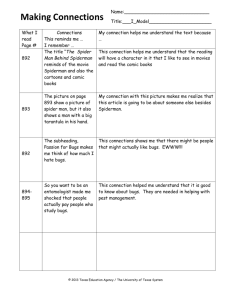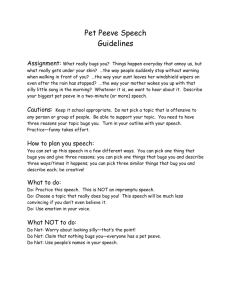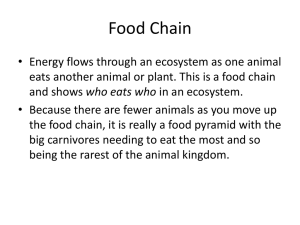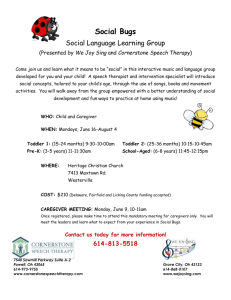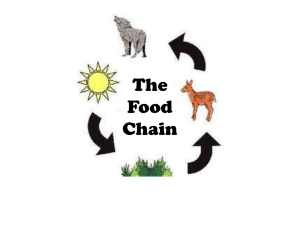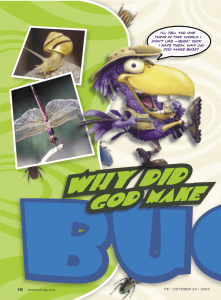The Web of Life.pp
advertisement
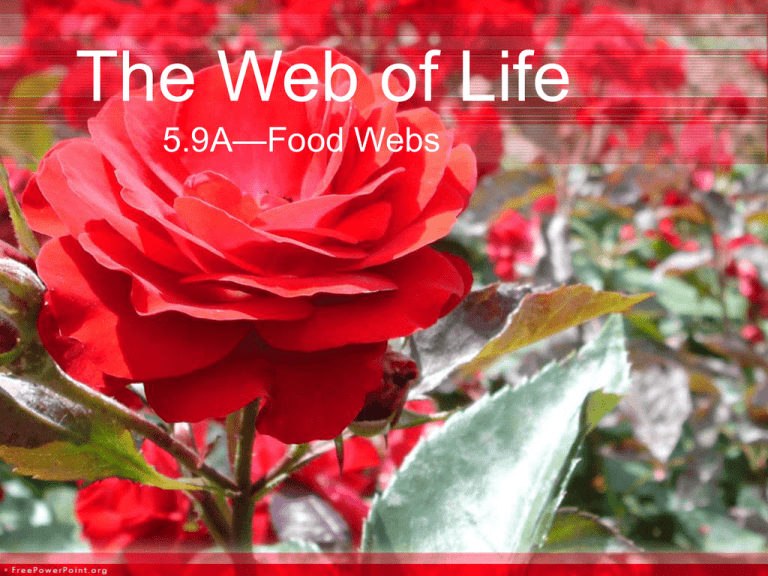
The Web of Life 5.9A—Food Webs The Web of Life Describe how the flow of energy derived from the sun, used by producers to create their own food, is transferred through a food chain and food web to consumers and decomposers. The Web of Life I am a spider. Just your average, run-of-the-mill, garden spider. You may have seen me 'hanging' around. I am going to explain the web of life to you because, you see, I am an expert on webs. Let’s see, where shall I start? Uhmm, yes, I’ll start by doing what I do best: weaving the web! The Web of Life You see, there are all sorts of creatures in the wild, and they each play a role in the web of life. There are lots of different kinds, or species, of plants and animals. They come in different sizes, shapes and colors. They live in different places and behave in very different ways. The Web of Life But for all their differences, plants and animals need a lot of the same things to survive. In fact, they need each other. That’s what the web of life is all about! Let me start at the very beginning with my very own web. The Web of Life You see, as a garden spider, I meet lots of plants and animals. Some of them are my friends, some of them are not so friendly, and some of them are my dinner! Since I am, after all, a garden spider, let me show you around my garden. The plants you see here are my friends. Plants are friends to everyone in the web of life. To tell you the truth, none of us could live without them! But don’t tell them that - they might get swelled heads over it. Oh, I guess you have a point. Plants don’t have heads, do they? The Web of Life So, there are millions of different kinds of plants all over the world! Plants are really quite simple. All they really need is sunlight and water! Plants may not seem very interesting. I mean, they can’t talk to you, right? So why am I friends with them? Well, believe me, none of the animals you’re about to meet would be around without plants, so we should all appreciate them! The Web of Life Plants are VERY important producers. They produce food for many other organisms!. Let me introduce you to some animals that eat plants! Lots of animals eat plants. Animals that eat only plants or plant parts are called herbivores. As a matter of fact, a whole lot of animals are herbivores. Let's see, how many animals can you name that eat plants? Here, let me help you. The Web of Life Now be very, very quiet. That guy over there, he's a bird. Some birds eat seeds, which come from plants! Some birds also eat wonderful little spiders like me, so don't let him see me! Quick, let's get out of here! The Web of Life Whew, that was close!!! Let's go talk to a squirrel. They don't eat spiders. They eat nuts (which also come from plants). I bet his friend over there is hiding nuts for the winter! The Web of Life Squirrels eat nuts, and they also bury them for storage to eat in the winter time. The ones they forget about will grow up to be trees and make more nuts! Squirrels and trees are very good friends. The Web of Life Oh dear, here comes a deer! Deer eat the leaves of plants. They don't bother me except when they walk through a spider web I've worked so hard to build. The Web of Life I better get back to work here, still talking about plants. You see, plants aren't just a source of food. For many animals, they're home! How can an animal live in a plant you ask? Just look at me! I build my spider webs between branches of trees or blades of grass. Other animals use grass to hide in, like baby deer (fawns). Other animals, like mice, use grass to build homes. The Web of Life Trees are homes for many animals. All kinds of birds, insects and squirrels can call a tree home. For large animals like bears and wolves, the whole forest is their home. It's what scientists call "habitat." The Web of Life I would introduce you to habitat, except habitat isn't a plant or an animal - it's a whole community of plants and animals! It's a lot like the town or city in which you live. It's where animals get the food they eat and the water they drink - it's just plain where they call home. Habitat is just as important to animals as animals are to each other. The Web of Life Now, let's get back to the story. Remind me again, where was I? Oh my! Now I remember! I completely forgot to tell you about bugs! Why, bugs are my favorite animals! I eat them! That makes me a carnivore, because I only eat meat! There are many kinds of bugs. And there are different bugs in different places. What kinds of bugs live near you? Have you seen any ants? How about crickets? Mmm . . . I love crickets. Where did you see them? I'll have to come visit you! The Web of Life Bugs do a lot of different things. Bees visit the flowers of plants and take nectar and use it to make honey. While the bee is collecting nectar, it usually gets a powder on it called pollen. This is sort of like when you walk in the woods and seeds get stuck to your pants. Bees fly from one flower to the next, carrying this pollen. Some of the pollen falls off into the flowers, and the plants use that to reproduce! The plant is helping the bees, and the bees are helping the plants! That works out pretty well, don't you think? The Web of Life Some bugs eat plants. Now I'm sure you've seen caterpillars before! Caterpillars eat lots and lots of leaves before they grow up and turn into moths or butterflies. But not every caterpillar grows up. Why not? Because birds eat them! Some birds are herbivores while other birds are carnivores. I'd introduce you to a caterpillar, but you see, I ate the last one I met. Well, don't look at me like that, I was hungry! The Web of Life Now that I'm full, I guess we can stop talking about what I eat and go meet some other animals. Follow me! Ah! Allow me to introduce you to Red, the fox, and Wiley, the coyote. Now gentlemen, would you describe each other as friends? "GRRR!" Oh my! Clearly not! The Web of Life Perhaps I can shed some light on the situation. You see, most animals eat lots of different things. Some animals are predators, which means they hunt and eat other animals. The animals they eat are called prey. And then there are some animals that scavenge for food. Scavengers eat other animals too, but, unlike predators, they don't do the hunting. They eat what other predators have killed or animals that have died of natural causes. Sometimes a hungry predator will scavenge for food when there's nothing else to eat. What does all that have to do with Red, the fox and Wiley, the coyote? Plenty, believe me! The Web of Life You see, even though Red the fox is a carnivore and a predator of rabbits and mice, sometimes the fox is the prey of the coyote! Keep that in mind, because the web of life is about to get very twisted - so hold on! The fox and the coyote are also competitors! Why? Because animals usually eat more than just one thing - they have to in order to survive! When two animals eat the same food, they're called competitors, because they are competing for a limited amount of the same food. Get it? You see, the fox and the coyote compete to eat mice and rabbits. The Web of Life I bet you're thinking that as a top predator, the carnivorous wolf is at the top of the food chain, right? Well, not exactly. You see, describing the web of life as a food chain isn't very accurate. . . The Web of Life Let me just climb up onto this wolf. Huh, huh, oh my, this is a long climb for me. There, made it! So here I am, standing in the fur on the back of a wolf. I don't usually do this sort of thing, but for you, I've made an exception. The Web of Life Let's see who we can meet up here. Hey, look! It's a family reunion! This is my distant cousin, the tick! Ticks feed off of the blood of other animals. You may have met one before, perhaps on your dog. They are called parasites. Mosquitoes and fleas - those wacky bugs - also feed off the blood of animals. I'm sure you've met a few of them in your time! The Web of Life So you see, even predators and carnivores are food for other animals. That's why there really isn't a "top" to a food chain or a food web. The Web of Life Even predators die sooner or later. Sometimes they die from old age or from injury. Other times they die when there's not enough food around. The Web of Life When a predator or its prey dies, some of it is usually eaten by scavengers. What they don't eat, bugs will eat, and so its body is broken down. What's left over eventually becomes part of the soil - providing nutrients to the soil and food for - you guessed it - plants! The Web of Life Carnivores (Tertiary Consumers) Carnivores (Secondary Consumers) Herbivores (Primary Consumers) Producers Decomposers The Web of Life So you see, in the web of life, every animal and every plant relies on other plants and animals to survive. The web of life isn't a chain, and it's not quite a circle. It's an important connection between all life, and no one part of it is more important than another. All animals and plants in a sense work together to survive. The Web of Life That's why preserving habitats and protecting endangered species is very important! So make sure you do your part. Be a Defender of Wildlife!
